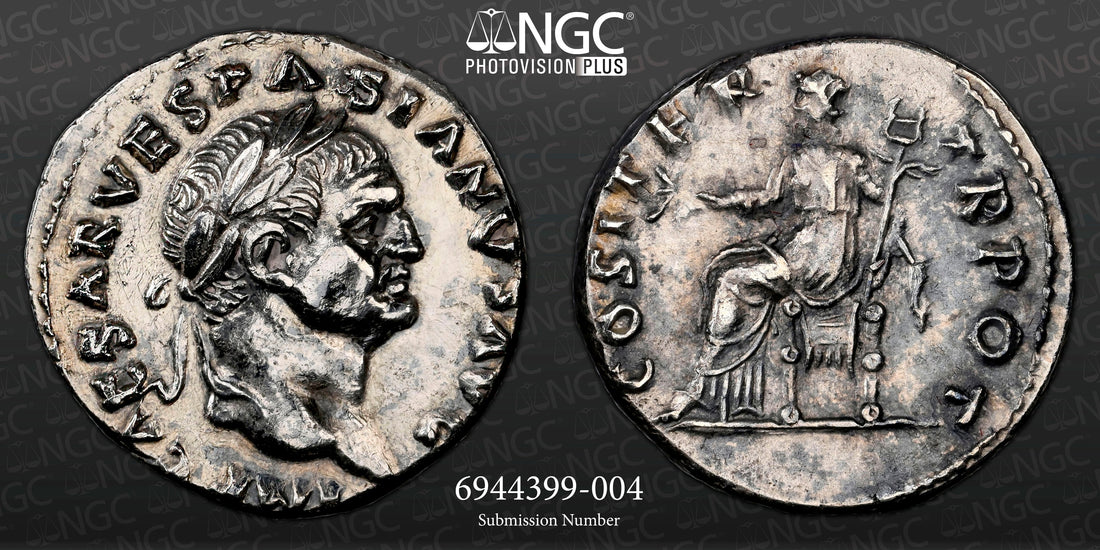
Vespasian Denarius (69-79 AD) - A Symbol of Peace and Power
Share
Vespasian’s reign was an important turning point for the Roman Empire. His rise to power came after the death of Emperor Nero and the subsequent civil wars that destabilized Rome. After defeating his rivals in the Year of the Four Emperors, Vespasian emerged victorious and set out to restore order to the empire. His reign marked the beginning of the Flavian dynasty, which would rule Rome for several decades. The symbolic use of Pax on the reverse of the coin emphasizes that Vespasian was not just a conqueror but also a ruler dedicated to peace and stability. After the years of instability, his government focused on rebuilding the empire, both politically and economically. Vespasian was known for his fiscal reforms, rebuilding efforts, and military campaigns, particularly in Judea, where he completed the conquest begun by his son Titus. The coin, therefore, was not just a piece of currency -it was a tool of imperial propaganda. It conveyed to the Roman people that Vespasian was the leader who could restore peace, bring prosperity, and secure Rome’s future after a period of great uncertainty.
The Obverse: A Portrait of Vespasian
On the obverse of the denarius, we find a portrait of Emperor Vespasian facing right, wearing a laurel wreath. The inscription surrounding his image reads: IMP CAESAR VESPASIANVS AVG.
The laureate head is a classical representation of a Roman emperor, signifying not only his imperial status but also his military achievements. The laurel wreath was a symbol of victory, honor, and power. By including this imagery, Vespasian was emphasizing his role as a victor and a strong leader of Rome. It's also important to note that this style of portrait, worn by the emperor during his reign, was a well-established tradition in Roman numismatics, used by many emperors to project strength, wisdom, and leadership.
The inscription, IMP CAESAR VESPASIANVS AVG, translates to "Imperator Caesar Vespasian Augustus." Here, Imperator refers to Vespasian’s command over the Roman legions, while Caesar signifies his connection to the Julian family line and imperial legitimacy. The title Augustus is a mark of his authority and revered status as the emperor.
The Reverse: Pax, Goddess of Peace
The reverse of the coin is equally significant, as it features Pax, the personification of peace, seated on the left side of the coin. She holds an olive branch in her right hand and cradles a transverse winged caduceus in her left arm. The inscription on this side reads COS ITER TR POT, which translates to "Consul for the second time, Tribune of the People."
The image of Pax is deeply symbolic, particularly given the context of Vespasian’s reign. Following the chaos of the Year of the Four Emperors (69 AD), which saw rapid changes in leadership and civil war, Vespasian's rise to power marked the restoration of stability to the empire. Pax was used on coins to signify the peace and calm that came with the new emperor's rule, following a period of turmoil.
The olive branch that Pax holds is one of the most widely recognized symbols of peace, used not only in Roman coinage but across various cultures throughout history. The caduceus, a staff entwined with two serpents and typically associated with the god Mercury, represents negotiation, harmony, and healing. The combination of the olive branch and the caduceus on the same coin underscores Vespasian’s message that his reign would bring both peace and prosperity to the empire, healing the wounds caused by years of civil conflict.
The inscription COS ITER TR POT provides insight into Vespasian's political titles and positions. COS ITER refers to his second term as consul, one of the highest political offices in the Roman Republic. TR POT refers to his powers as Tribunicia Potestas (tribunician power), which gave him the authority to act on behalf of the Roman people, a title that was crucial to maintaining his control over the government.
The Power of Coinage
Roman coins, particularly those minted during the reign of Vespasian, provide us with invaluable insights into the emperor's image and political messaging. Coins were distributed throughout the empire, reaching not only the elite but also the common people and soldiers. They were an effective way for emperors to project their power, communicate political ideologies, and promote imperial propaganda.
In this context, the Vespasian denarius served as both a reminder of the emperor’s authority and a symbol of the peace and stability he promised. The use of Pax on the reverse was a deliberate choice to communicate that Vespasian’s rule would bring an end to the conflict and usher in a new era of prosperity for the empire.
A Legacy of Peace and Prosperity
The Vespasian denarius, minted between 69-79 AD, is a powerful testament to the emperor’s vision of restoring peace and stability to the Roman Empire after years of chaos. Through the imagery of Pax, the olive branch, and the caduceus, Vespasian communicated a message of healing and prosperity for Rome. As the first emperor of the Flavian dynasty, he successfully laid the foundation for a period of relative peace and economic stability that would characterize much of the next few decades.
For collectors and historians, this coin is not just a relic of the past - it is a symbol of an emperor’s determination to restore Rome to its former glory. Whether viewed for its artistry or its political significance, the Vespasian denarius remains a remarkable example of Roman numismatics and imperial ideology.
